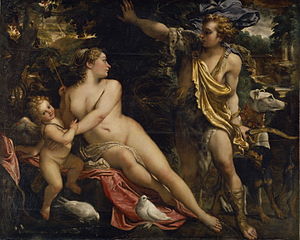
Agostino Carracci was an Italian painter, printmaker, tapestry designer, and art teacher. He was, together with his brother, Annibale Carracci, and cousin, Ludovico Carracci, one of the founders of the Accademia degli Incamminati in Bologna. Intended to devise alternatives to the Mannerist style favored in the preceding decades, this teaching academy helped propel painters of the School of Bologna to prominence.

Antonio Allegri da Correggio, usually known as just Correggio, was the foremost painter of the Parma school of the High Italian Renaissance, who was responsible for some of the most vigorous and sensuous works of the sixteenth century. In his use of dynamic composition, illusionistic perspective and dramatic foreshortening, Correggio prefigured the Baroque art of the seventeenth century and the Rococo art of the eighteenth century. He is considered a master of chiaroscuro.

Annibale Carracci was an Italian painter and instructor, active in Bologna and later in Rome. Along with his brother and cousin, Annibale was one of the progenitors, if not founders of a leading strand of the Baroque style, borrowing from styles from both north and south of their native city, and aspiring for a return to classical monumentality, but adding a more vital dynamism. Painters working under Annibale at the gallery of the Palazzo Farnese would be highly influential in Roman painting for decades.
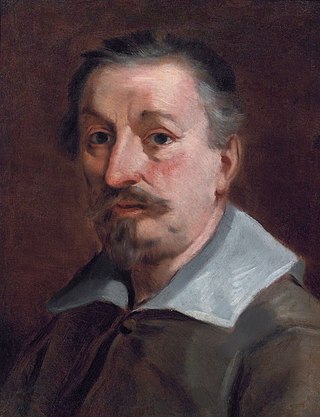
Francesco Albani or Albano was an Italian Baroque painter who was active in Bologna (1591–1600), Rome (1600–1609), Bologna (1609), Viterbo (1609–1610), Bologna (1610), Rome (1610–1617), Bologna (1618–1660), Mantova (1621–1622), Roma (1623–1625) and Florence (1633).

The Loves of the Gods is a monumental fresco cycle, completed by the Bolognese artist Annibale Carracci and his studio, in the Farnese Gallery which is located in the west wing of the Palazzo Farnese, now the French Embassy, in Rome. The frescoes were greatly admired at the time, and were later considered to reflect a significant change in painting style away from sixteenth century Mannerism in anticipation of the development of Baroque and Classicism in Rome during the seventeenth century.
Venus and Adonis may refer to:
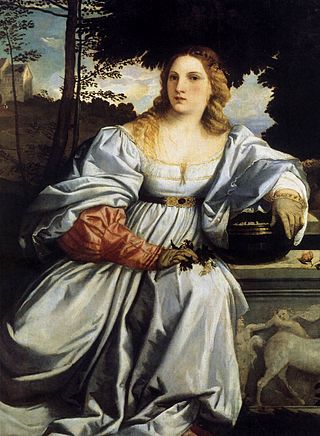
Sacred and Profane Love is an oil painting by Titian, probably painted in 1514, early in his career. The painting is presumed to have been commissioned by Niccolò Aurelio, a secretary to the Venetian Council of Ten, whose coat of arms appears on the sarcophagus or fountain, to celebrate his marriage to a young widow, Laura Bagarotto. It perhaps depicts a figure representing the bride dressed in white, sitting beside Cupid and accompanied by the goddess Venus.

The Death of Actaeon is a late work by the Italian Renaissance painter Titian, painted in oil on canvas from about 1559 to his death in 1576 and now in the National Gallery in London. It is very probably one of the two paintings the artist stated he had started and hopes to finish in a letter to their commissioner Philip II of Spain during June 1559. However, most of Titian's work on this painting possibly dates to the late 1560s, but with touches from the 1570s. Titian seems never to have resolved it to his satisfaction, and the painting apparently remained in his studio until his death in 1576. There has been considerable debate as to whether it is finished or not, as with other very late Titians, such as the Flaying of Marsyas, which unlike this has a signature, perhaps an indication of completion.

The Venetian painter Titian and his workshop made at least six versions of the same composition showing Danaë, painted between about 1544 and the 1560s. The scene is based on the mythological princess Danaë, as – very briefly – recounted by the Roman poet Ovid, and at greater length by Boccaccio. She was isolated in a bronze tower following a prophecy that her firstborn would eventually kill her father. Although aware of the consequences, Danaë was seduced and became pregnant by Zeus, who, inflamed by lust, descended from Mount Olympus to seduce her in the form of a shower of gold.
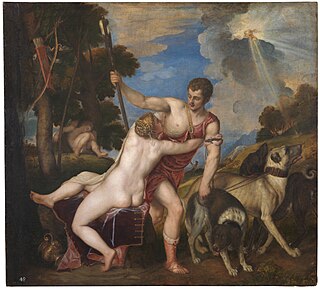
A composition of Venus and Adonis by the Venetian Renaissance artist Titian has been painted a number of times, by Titian himself, by his studio assistants and by others. In all there are some thirty versions that may date from the 16th century, the nudity of Venus undoubtedly accounting for this popularity. It is unclear which of the surviving versions, if any, is the original or prime version, and a matter of debate how much involvement Titian himself had with surviving versions. There is a precise date for only one version, that in the Prado in Madrid, which is documented in correspondence between Titian and Philip II of Spain in 1554. However, this appears to be a later repetition of a composition first painted a considerable time earlier, possibly as early as the 1520s.

Venus and Adonis is a painting by the Italian late Mannerist artist Paolo Veronese, executed in the early 1580s, now in the Museo del Prado, in Madrid.

The Worship of Venus is an oil on canvas painting by the Italian artist Titian completed between 1518 and 1519, housed at the Museo del Prado in Madrid, Spain. It describes a Roman rite of worship conducted in honour of the goddess Venus each 1 April. On this occasion, women would make offerings to representations of the goddess so as to cleanse "every blemish on their bodies".

Venus and Musician refers to a series of paintings by the Venetian Renaissance painter Titian and his workshop.

The Carracci were a Bolognese family of artists that played an instrumental role in bringing forth the Baroque style in painting. Brothers Annibale (1560–1609) and Agostino (1557–1602) along with their cousin Ludovico (1555–1619) worked collaboratively. The Carracci family left their legacy in art theory by starting a school for artists in 1582. The school was called the Accademia degli Incamminati, and its main focus was to oppose and challenge Mannerist artistic practices and principles in order to create a renewed art of naturalism and expressive persuasion.

The Garden of Love is a painting by Rubens, produced in around 1633 and now in the Prado Museum in Madrid. The work was first listed in 1666, when it was hung in the Royal Palace of Madrid, in the Spanish king's bedroom. In early inventories, the painting was called The Garden Party.
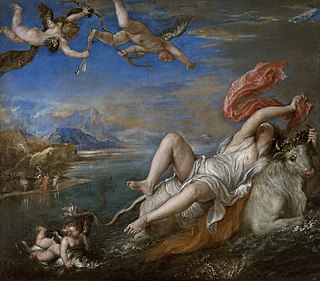
The Rape of Europa is a painting by the Venetian artist Titian, painted ca. 1560–1562. It is in the permanent collection of the Isabella Stewart Gardner Museum of Boston, Massachusetts. The oil-on-canvas painting measures 178 by 205 centimetres.
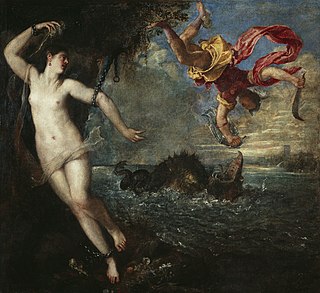
Perseus and Andromeda is a painting by the Italian Renaissance artist Titian, now in the Wallace Collection in London. It was painted in 1554–1556 as part of a series of mythological paintings called "poesie" ("poetry") intended for King Philip II of Spain. The paintings took subjects from the Roman poet Ovid's Metamorphoses, in this case Book IV, lines 663–752, and all featured female nudes.

The Pardo Venus is a painting by the Venetian artist Titian, completed in 1551 and now in the Louvre Museum. It is also known as Jupiter and Antiope, since it seems to show the story of Jupiter and Antiope from Book VI of the Metamorphoses. It is Titian's largest mythological painting, and was the first major mythological painting produced by the artist for Philip II of Spain. It was long kept in the Royal Palace of El Pardo near Madrid, hence its usual name; whether Venus is actually represented is uncertain. It later belonged to the English and French royal collections.

In 1635, Peter Paul Rubens created Venus and Adonis, now in the Metropolitan Museum of Art, New York. He followed the mythological story in the Metamorphoses by Ovid, inspired from his love of classical literature and earlier depictions of this scene. This oil on canvas painting shows Venus accompanied by Cupid, embracing and pulling Adonis before he goes off to hunt. The artist uses specific colors, detail and strong contrast between light and dark to depict a dramatic and emotional scene. At the time Rubens created the painting, the mythological story of Venus and Adonis was popular in Renaissance and Baroque court art. Rubens was clearly inspired by the many existing depictions of this scene, in particular the famous Titian composition of the same name, of which there are numerous versions. This depicts the same moment of Adonis leaving Venus to hunt, despite her pleas to stay. He is killed later in the day.

Christ and the Canaanite Woman is a 1594-1595 oil on canvas painting by Annibale Carracci, now in the Pinacoteca Stuard in Parma.
